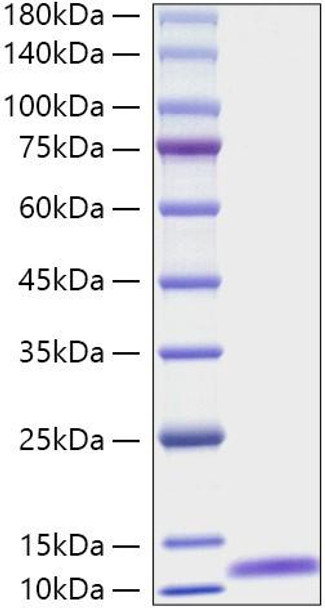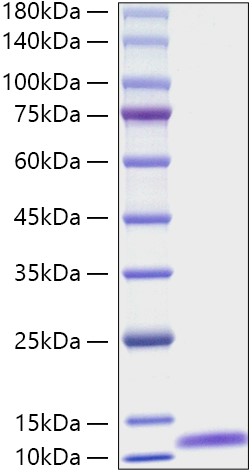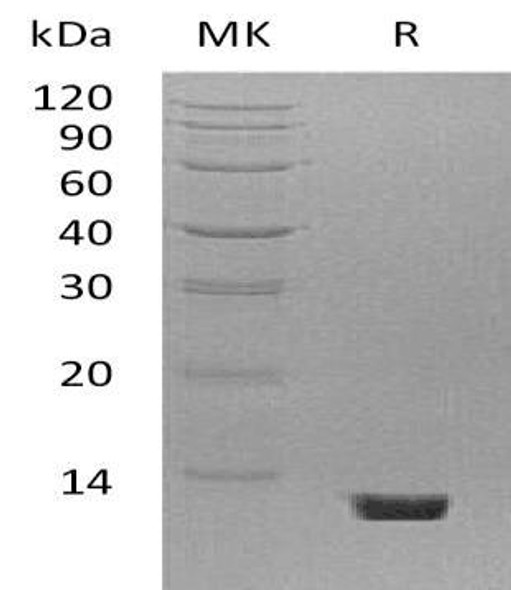Description
Recombinant Mouse Complement C5A Protein
The Recombinant Mouse Complement C5A Protein is a high-quality recombinant protein designed for murine biological research applications. This protein serves as an essential reagent in mouse model studies, comparative immunology research, and preclinical therapeutic evaluations, enabling scientists to investigate Complement C5A biology and its relevance to human disease mechanisms through translational research approaches.
This product (SKU: RPCB1934) is produced using E.coli and features a No tag tag for convenient detection and purification. The protein exhibits a calculated molecular weight of 9 kDa with an observed molecular weight of 9-10 kDa under denaturing conditions, achieving ≥ 95 % as determined by SDS-PAGE;≥ 90 % as determined by HPLC., ensuring exceptional quality and consistency for research applications.
Key Features
| High Purity by Affinity Chromatography | |
| Mammalian & Bacterial Expression Systems | |
| High lot-to-lot consistency via strict QC |
| Product Name: | Recombinant Mouse Complement C5A Protein |
| SKU: | RPCB1934 |
| Size: | 100 μg |
| Reactivity: | Mouse |
| Synonyms: | complement component 5, C5a |
| Tag: | No tag |
| Expression Host: | E.coli |
| Calculated MW: | 9 kDa |
| Observed MW: | 9-10 kDa |
| Gene ID: | 15139 |
| Protein Description: | High quality, high purity and low endotoxin recombinant Recombinant Mouse Complement C5A Protein (RPCB1934), tested reactivity in E.coli and has been validated in SDS-PAGE.100% guaranteed. |
| Endotoxin: | Please contact us for more information. |
| Purity: | ≥ 95 % as determined by SDS-PAGE;≥ 90 % as determined by HPLC. |
| Formulation: | Lyophilized from sterile PBS, pH 7.4. Contact us for customized product form or formulation. |
| Reconstitution: | Centrifuge the vial before opening. Reconstitute to a concentration of 0.1-0.5 mg/mL in sterile distilled water. Avoid vortex or vigorously pipetting the protein. For long term storage, it is recommended to add a carrier protein or stablizer (e.g. 0.1% BSA, 5% HSA, 10% FBS or 5% Trehalose), and aliquot the reconstituted protein solution to minimize free-thaw cycles. |
| Storage: | Store at -20℃.Store the lyophilized protein at -20℃ to -80 ℃ up to 1 year from the date of receipt. After reconstitution, the protein solution is stable at -20℃ for 3 months, at 2-8℃ for up to 1 week. |
C5a is a protein fragment released from complement component C5. This 74 amino acid peptide in humans is generated by the cleavage of C5a convertase on the C5 α-chain during the classical, alternative, and lectin pathways of complement activation. The structure of C5a includes a core region consisting of four, anti-parallel alpha-helices held together by three disulfide linkages and a structured C-terminal tail, and C5a is rapidly metabolised by carboxypeptidase B to a 73 amino acid low activity form, C5a des-Arg. C5a is an extremely potent proinflammatory mediator, as well as a potent chemotactic factor for neutrophils and other leukocytes. It causes histamine release, increases in vascular permeability, induces several cytokines production from leukocytes, enhances neutrophil-endothelial cell adhesion, and augments the humoral and cell-mediated immune response. C5a is quickly metabolised by carboxypeptidases, forming the less potent C5adesArg. Acting via a classical G protein-coupled receptor, CD88, C5a and C5adesArg exert a number of effects essential to the innate immune response, while their actions at the more recently discovered non-G protein-coupled receptor, C5L2 (or GPR77), remain unclear. The widespread expression of C5a receptors throughout the body allows C5a to elicit a broad range of effects. Thus, C5a has been found to be a significant pathogenic driver in a number of immuno-inflammatory diseases, making C5a inhibition an attractive therapeutic strategy. C5a is a strong chemoattractant and is involved in the recruitment of inflammatory cells such as neutrophils, eosinophils, monocytes, and T lymphocytes, in activation of phagocytic cells and release of granule-based enzymes and generation of oxidants, all of which may contribute to innate immune functions or tissue damage. Accordingly, the anaphylatoxin C5a is implicated in a variety of diseases such as rheumatoid arthritis, systemic lupus erythematosus, reperfusion injury, Alzheimer's disease, and sepsis.







